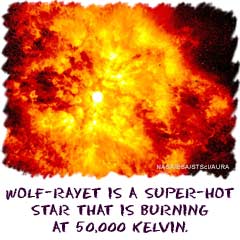|
|
||||||||||||||||||||
 |
|

|
||||||||||||||||||
Studying Stars When scientists first started to study stars, certain differences became noticeable. They had different colors, different intensities, and even different movement. The time had come to develop with a system of classification for stars.
When scientists first started to study stars, certain differences became noticeable. They had different colors, different intensities, and even different movement. The time had come to develop with a system of classification for stars.
Scientific ClassificationScience has always used different forms of classification when it studies natural phenomena. When they look at living organisms in biology, they have a system. The biological classification is based on your species. You could be an animal, plant, virus, or fungus. Depending on what you are, you will have certain common traits with other organisms that are like you.Math uses classification as well. If a mathematician is presented with a series of numbers and asked to organize them, they look for patterns. Then mathematicians determine a formula that will give them the numbers they want. For example, a mathematician is given a list of fifty numbers. They then chart them out and see that they make a curve. They can then determine a formula for the curve. That formula classifies the set of numbers from other random numbers in the list. Star ClassesAstronomers classify stars by their temperature. Temperature determines much of the activity of a star. You can even figure out how old it is when you know the temperature. Astronomers at Harvard College Observatory came up with the system and applied letters to each class. Some of the letters are O, B, A, F, G, K, M, R, N and S. That list can tell an astronomer how hot the star is. The "O"s are the hottest with temperatures over 25,000 Kelvin. The cooler stars are at the other end of the list with "M" stars at less that 3,500 Kelvin. As a reminder, water boils at 373 Kelvin. |

|
|||||||||||||||||||
Useful Reference MaterialsEncyclopedia.com (Stellar Magnitudes):http://www.encyclopedia.com/topic/Stellar_magnitudes.aspx Wikipedia (Stellar Classification): http://en.wikipedia.org/wiki/Stellar_classification Encyclopædia Britannica (Star Cluster): http://www.britannica.com/EBchecked/topic/563485/star-cluster | ||||||||||||||||||||
|
RETURN TO TOP or Search for more information... * The custom search only looks at Rader's sites. |
|||||||||||||||||||
©copyright 1997-2015 Andrew Rader Studios, All rights reserved. Current Page: Cosmos4Kids.com | Stars | Classes of Stars |
||||||||||||||||||||
|
|
||||||||||||||||||||

